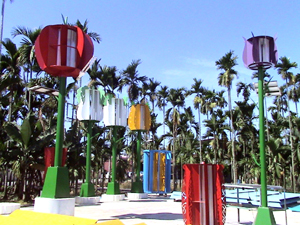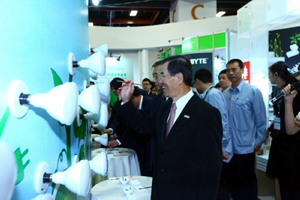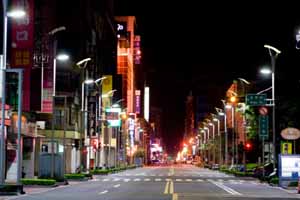Energy-efficient Lighting Plays Key Role in Green Building
2012/01/04 | By Michelle Hsu“Green building” is a new term that refers to environment-friendly architecture built with green materials and designs. One common feature shared by all green buildings is energy-saving illumination equipment.

The new green-building trend was the theme of the Taiwan Smart Green City Expo 2011 (BuilG Taiwan 2011), held for the first time by the Taiwan External Trade Development Council (TAITRA) on October 26-29, and the Taipei International Construction Material, Lighting, and Furniture Show organized by the Economic Daily News in November. Both of the exhibits had energy-saving lighting areas for the display of lighting products that could play a key role in green buildings and green cities.
Smart Green Cities
BuilG Taiwan, held in conjunction with the Taiwan International Green Industry Show and Green Life Expo, was arranged around three major themes: “Smart Green Buildings,” “Total Green Building Solutions,” and “Green City Plan.” The shows were accompanied by the Taiwan Smart Green City Summit, where Taipei Deputy Mayor Chen Hsiung-wen, Tainan Deputy Mayor Lin Chin-rong, and other government officials and industry representatives discussed the prospects of green city development in Taiwan.

A survey report published by the Economist Intelligence Unit (EIU) in February ranked Taipei as the second greenest city in Asia, behind only Singapore. In response, the Taipei City Government said that it would continue to promote green buildings with the aim of having them in all of the city’s 12 administrative districts.
Deputy Mayor Lin of Tainan City, which is home to half of all solar energy manufacturers in Taiwan, stated his belief that green technology will be the most promising industry in the 21st century, and that Tainan will continue to promote the development of green industries as its major engine for economic growth.
Hsinchu in northern Taiwan is the island’s most active city in planning for urban illumination. It has signed a memorandum of understanding with Cree Inc. of the U.S. to become a member of Cree’s LED City Program, under which the American company will provide total solutions for the creation of an energy-efficient lighting environment. According to Cree’s Taiwan partner, Leadray Energy Co., Hsinchu is the first city in Taiwan and 25th in the world to join the program.
With its commitment to providing an eco-friendly living environment, Hsinchu set up a low-carbon center several years ago and has replaced more than 3,000 traditional traffic and parking-lot lights with LED lamps. By the end of 2009, Hsinchu’s installed LED lighting was saving an estimated 244,513 watts per hour, translating into a 15,160-ton reduction in CO2 emissions and cost savings of NT$531,360.
Lighting for Green Buildings
Leadray Energy is a manufacturer of LED road lamps located in the Hsinchu Science Park. The company’s president, Lin Chen-feng, noted that the making of LED road lamps is an industry that is facing ever-stricter consumer demands. “Whether in tinge, brightness, or effect,” Lin commented, “there is always room for improvement.”

The company, whose LED road lamps have obtained UL, CE, and CNS certification, controls core technologies for heat dispersion, anti-oxidation, and lighting transparency, ensuring that its lamps have a brightness of over 90 Lum. Testing shows that its road lamps lose less than 1% of their brightness after 4,000 hours of use and less than 2% after 5,000 hours.
Aeon Lighting Technology (ALT), a producer of smart lighting products, is in the process of developing lighting products combined with solar panels so as to provide self-sufficient lighting power. At the 2011 “Taipei Summit—ITC and Green Energy Applications in Architecture,” held in October by the Bureau of Foreign Trade (an agency of the Ministry of Economic Affairs), ALT general manager Baly Lo was invited to explain how LED lighting speeds up the development of green architecture.
In his talk, Lo noted that “LED lighting is the best lighting equipment for green architecture because of its unique advantages: it is mercury-free, non-toxic, and energy-saving, and is highly efficient at converting electricity to light.” In addition, he added, LED bulbs generate less head than incandescent bulbs, so “Switching to LED light bulbs can help reduce indoor temperatures and reduce the use of air conditioning. That will help protect the ozone layer.”
Lo reports that his company has begun cooperating with foreign governments in the development of intelligent LED lighting systems. It has so far secured the support of Japanese, German, and African governments for LED lighting programs that help them save an estimated US$500,000 in electricity costs per year.
Xodtec Group USA, Inc., set up in the state of Nevada by a Taiwanese businessman in 2005, focuses on illumination equipment planning for construction projects. The round LED roof of the new Fullon Hotel Hualien uses 40W High Power LED lighting products from Xodtec, and since completion in 2010 it has become a landmark of the Hualien Harbor area. Xodtec products also light up the “LED garden” at United University in Miaoli County with 40W High Power LED spotlights.
The Fung Gin Da Energy Science and Technology Co., which has dedicated itself to the production of wind-driven generators for years, recently completed the development of multi-functional models that use LED lighting to expand the application of the wind generators to parks, schools, boarding houses, streets, and even the gardens of private homes.
The Da Lin Co., which has worked with lighting fixtures for 25 years, recently won patents for a new lighting socket which is integrated with air conditioning systems to save on the cost of construction materials as well as to save on electricity. The company says that the socket is only 4 cm thick, compared with 6.5 cm for traditional sockets.
Indoor Farming
In addition to the energy-saving appeal, some green buildings use LED lighting to create indoor gardens or farms so that city dwellers can experience the joys of growing plants. The Pacific Construction Co., one of the top builders in Taiwan, has launched a new project in the Muzha District of Taipei City, claimed to be the first of its kind, with indoor farming facilities. Its residents will be able to grow their own pesticide-free vegetables and fruits.

The bright prospects of indoor farming have encouraged one manufacturer after another to develop LED lighting designed specifically for use with indoor farmland. The Everlight Electronics Co., for example, has launched such products in the U.S., China, and other markets where farming is affected by seasonal climate changes or when periods of abundant sunlight are short, like Japan and Northern Europe.
According to the MOEA, which has mapped out policies to promote the development of the LED lighting industry in Taiwan, notes that Japan has done pioneering work on LED plant lighting for years, but believes that with a boost in its efforts Taiwan will be able to catch up quickly.
As a fourth-generation lighting source, an MOEA official commented, the LED is perfect for indoor farming because its light spectrum perfectly matches the needs of plants for carrying out photosynthesis.

